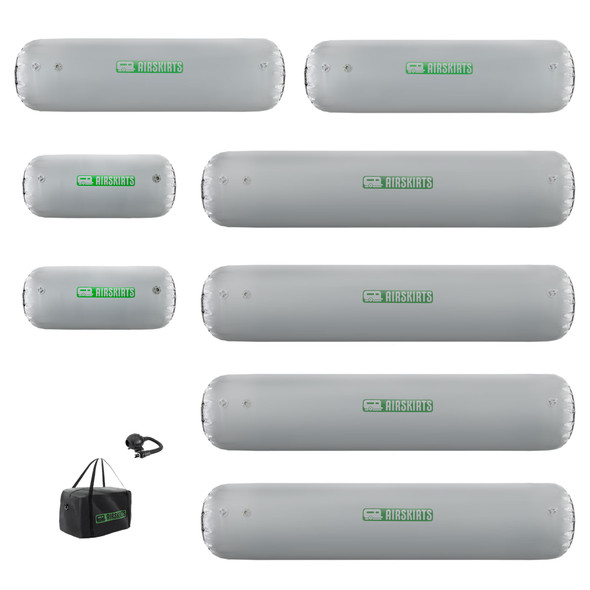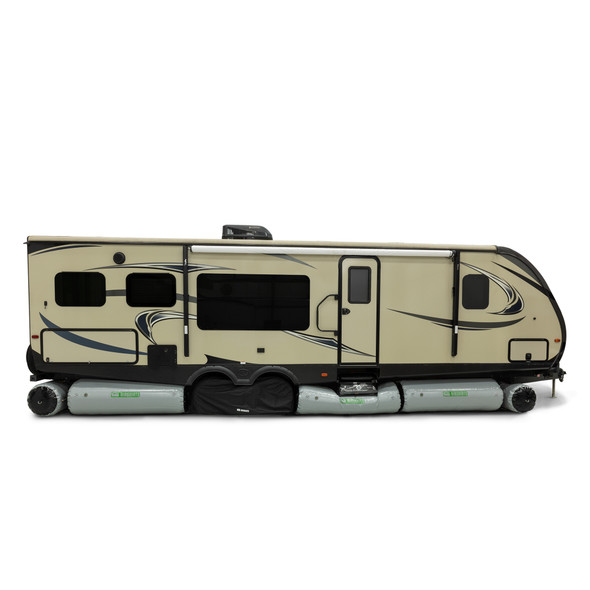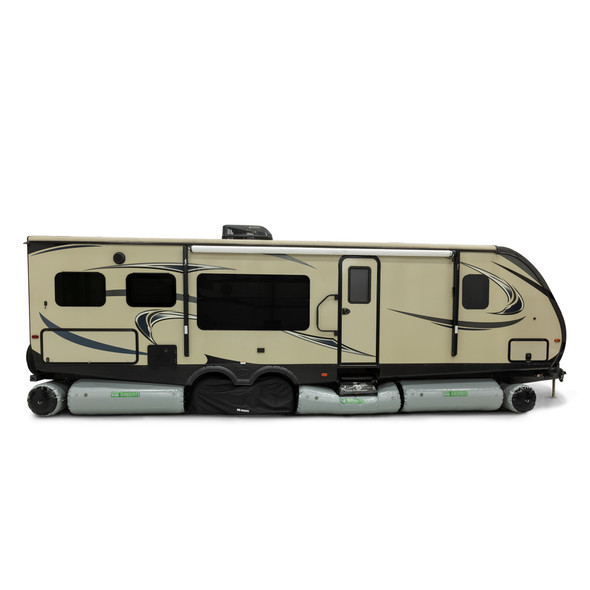Using your RV in extreme weather conditions can take a pretty big toll on it. Even in moderate weather conditions, not protecting your rig can lead to extra costs and inconveniences. Let’s take camping in the cold, for example. The cold weather can freeze your plumbing and water pipes, can cause freeze damage on the underside of your RV, can lead to inflated heating costs to try and keep you comfortable inside the living space, and can lead to a more uncomfortable camping experience. And in hot summer heat, the weather can lead to increased cooling costs and a more uncomfortable living environment.
This is where RV skirting comes into play. The job of an RV skirt isn’t just to make your rig look more put together. It helps keep your RV temperature-controlled through trapping the air under your rig and keeping out the air around it. This creates an insulating layer which can be warmed or cooled through convection by contact with the bottom of your camper. This air keeps your pipes from freezing in the cold weather and keeps you comfortable and keeps down cooling and heating costs no matter the weather. As a general note, the thickness of the material you use isn’t as important as sealing any gaps that you might have in the skirting, which could let air blow into it. The tight seal between your RV, the skirting, and the ground is of utmost importance, keeping the insulating layer temperature controlled and stable.
Do I Need RV Skirting?
RV skirting protects your plumbing and tanks, keeps you warmer or cooler and more comfortable, helps you save on propane and electricity from temperature control costs, allows you to still use your plumbing system even in cold weather camping, protects your tires with the right add ons, and even provides extra storage space under your rig. But do you really need one?
If you’re debating whether you need a skirt for your rig, just ask yourself these questions:
- Do I feel cold in my RV?
- Will I be using my RV in freezing temperatures?
- Do I live in my RV full-time?
- Do I want to make sure my undercarriage is in good condition no matter where I go?
If your answer to any of these questions is yes, then you are going to need an RV skirt. And if you’re worried about finding the right kind of skirting, we’ve got you covered. With our selection of high-quality RV skirting, you can get all of the benefits without the confusion of finding a good one among all of the other models.
AirSkirt FAQ
With our line of high-quality, efficient AirSkirt RV skirting, we would be shocked if no one ever had any questions. To help you get a better grasp of all that the AirSkirts have to offer, we have a list of commonly asked questions and their answers. Check them out below!
Do I have to modify my RV or bring it to a shop to use AirSkirts?
- Absolutely not! In fact, this is one of the biggest advantages AirSkirts offers compared to traditional RV skirts. PVC sheeting and other types of manufactured skirts require you to install snaps onto your RV, meaning you (or a shop) has to drill into your beautiful, expensive RVs body and add unsightly snaps. Some of these skirts offer snaps that will adhere to your RV, but these are unreliable and must be spaced very closely together and still may fall off. AirSkirts simply inflates underneath your RV creating a tight seal. For this reason, AirSkirts is the absolute fastest way to skirt (and unskirt) your RV, with an average deployment taking under 20 minutes and packs up just as quickly.
Should I use AirSkirts in warmer weather?
- Absolutely yes! Although there is no risk of pipes freezing in warmer weather the insulating properties of AirSkirts will help keep your RV cool by preventing cool air from escaping through your floor, conserving energy, and will prevent debris from getting underneath.
Will AirSkirts work for my fifth-wheel?
- Short answer: yes. Though AirSkirts aren't appropriate for the elevated portion or slides of your fifth-wheel trailer, the entire base of your trailer can (and should!) use AirSkirts and you’ll get all of the benefits the product offers. While many fifth-wheelers choose not to skirt their elevated portion at all, you could investigate a more traditional skirting method for that portion – consider that these areas do not typically have pipes that are susceptible to freezing and traditional skirts act more as a wind break and offer very limited insulating properties. Because fifth-wheels typically have a higher ground clearance than other trailers, please measure the ground clearance and order a high clearance kit if between 21 and 32 inches. If you’re unsure or have a higher clearance than 32 inches, don’t hesitate to contact us!
How do AirSkirts handle things like sewage pipes, hose holders, etc?
- Don’t worry, you’ll still have access to your sewage drain. Simply place the AirSkirts tube under the drain area and inflate – the tube will inflate to conform around the irregular areas. Because the skirts are modular, you can place them so the ends of the tubes meet at any odd protrusions.
How do AirSkirts work with slide-outs?
- AirSkirts are concerned with the core of your trailer – think of wearing a vest – the system protects and insulates the main body of your trailer (or coach) and protects the most vulnerable areas where water pipes are and where the majority of heat or cold dissipates. For slide outs, you’ll get insulation by the use of furniture, carpeting, and window insulation. AirSkirts will not interfere with the operation of your slides.
Do AirSkirts work well in high wind?
- AirSkirts are very resilient in high wind. While other skirting methods hold up poorly in high wind conditions, AirSkirts are pinned between the ground and the RV by air pressure, meaning you can kick an AirSkirts tube and it won’t budge. The skirts deal equally well with pressure from accumulating snow – snow will actually add to the insulating properties! A vinyl skirt can tear or pull off the snaps in high winds or with the weight of snow. AirSkirts will stay safely tucked under your RV.
How do I set up AirSkirts?
- Every AirSkirts kit comes with detailed instructions in the Owner’s Manual, which you can view here, but it couldn’t be simpler. Just place the skirt tubes under the perimeter of the RV (or structure) into position, insert the end of the included pump into the valve until the tube begins to push against the solid underside or I-beam. Repeat all around, and you’re done!

 $164.95
$164.95
 $3,469.95
$3,469.95
 $3,124.95
$3,124.95
 $2,659.95
$2,659.95
 $2,204.95
$2,204.95
 $2,094.95
$2,094.95